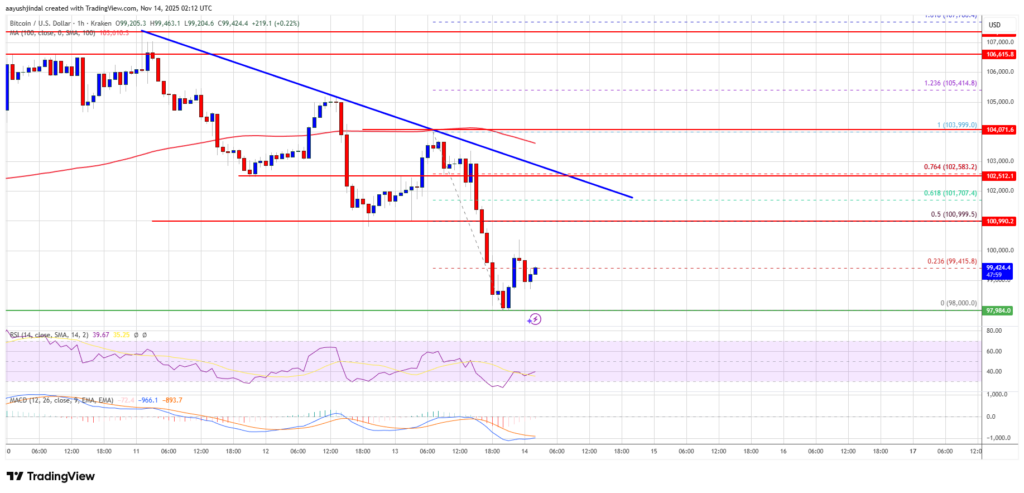Bitcoin falls below $100,000, crypto market under pressure
The king of cryptos gave up ground yesterday, slipping below the symbolic threshold of $100,000. Investors are fleeing risky assets in a context of liquidity tightening. This brutal correction raises the question: are we witnessing a simple technical pullback or the beginning of a prolonged bearish phase?

In brief
- Bitcoin drops more than 4% and struggles to maintain the $100,000 mark.
- Sellers dominate the market after failing to stay above $103,500.
- A bearish trend line has formed with a key resistance at $102,200.
- Long-term investors show signs of capitulation by liquidating positions.
Bitcoin falls below $100,000 and worries markets
Bitcoin abruptly broke several critical supports this Thursday. The crypto star dropped from $103,999 to a floor of $98,000 within a few hours. Sellers took control after the price failed to break above $103,500, a pivot level separating optimism and caution.
Technical analysis reveals a worrying situation. BTC now trades below its 100-hour moving average and faces a bearish trend line with resistance at $102,200.
Indicators confirm the gloomy mood: the MACD accelerates in negative territory while the Relative Strength Index (RSI) plunges below the 50-point threshold.
Rebound attempts hit a wall of resistances. If buyers try to climb back, they must first break $100,500 and then $101,000, corresponding to the 50% Fibonacci retracement.
Beyond that, the $102,200-$103,500 zone represents a major obstacle before hoping to reclaim recent highs.
The opposite scenario is more worrying. If these levels are not regained, Bitcoin could plunge towards $96,500 or even $95,000 in the short term. Analysts set the main support at $92,500, a threshold whose breach would pave the way for a bearish acceleration.
 Technical analysis of bitcoin (BTC/USD). Source: TradingView/NewsBTC
Technical analysis of bitcoin (BTC/USD). Source: TradingView/NewsBTC
Macroeconomic factors paralyzing the market
The macroeconomic environment largely explains this risk aversion. The longest shutdown in American history just ended, but its effects continue to be felt.
Unlike 2019 when a similar situation propelled Bitcoin by 300%, this time the crypto has suffered a 12% decline since the start of the budget deadlock.
The paralysis of federal agencies like the SEC and CFTC has frozen all regulatory progress. Expected ETF approvals remain on hold, while discussions on a legal framework for cryptos are stalled. This uncertainty deters institutional capital, essential for the next bullish phase.
The probability of a Fed rate cut in December has dropped to 67%, from over 90% in previous months. This abrupt monetary policy reversal cools enthusiasm. Paul Howard, director at Wincent, notes that “cryptocurrency is now more than ever closely linked to macroeconomics.”
Equity markets amplify the movement. The Nasdaq loses 2% and the S&P 500 gives up 1.3%, dragging crypto stocks down. Miners exposed to AI infrastructure suffer the biggest losses: Bitdeer collapses 19%, Bitfarms 13%. Exchange platforms are not spared, with declines between 7% and 8%.
Some rays of hope remain. JPMorgan maintains its $170,000 target within six to twelve months, relying on miners’ production costs at $94,000 which represent a solid floor.
Additionally, Taiwan is preparing a report to evaluate integrating bitcoin into its strategic national reserves by the end of 2025, a signal that could inspire other Asian nations.
Necessary consolidation before rebound?
The crypto market is going through a phase of questioning. November, traditionally the best performing month with an average increase of 41.78% since 2013, is so far disappointing expectations. However, this consolidation could prove beneficial after October’s euphoria and the historic peak at $125,100.
Analysts remain divided. Some see in this pullback an accumulation opportunity , others fear 2025 highs might already be behind us. The answer will largely depend on the return of liquidity to the markets and clarification of US monetary policy in the coming weeks.
Disclaimer: The content of this article solely reflects the author's opinion and does not represent the platform in any capacity. This article is not intended to serve as a reference for making investment decisions.
You may also like

Polkadot native stablecoin pUSD is coming! Differences, risks, and unresolved questions compared to HOLLAR!



